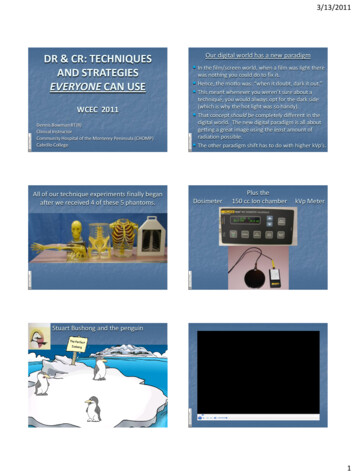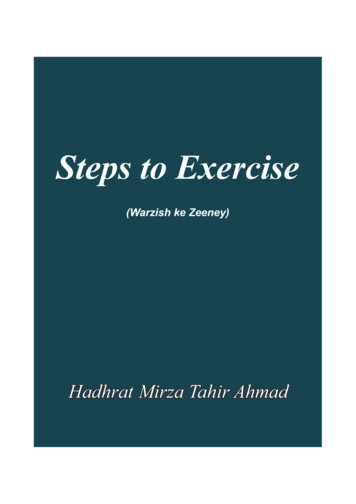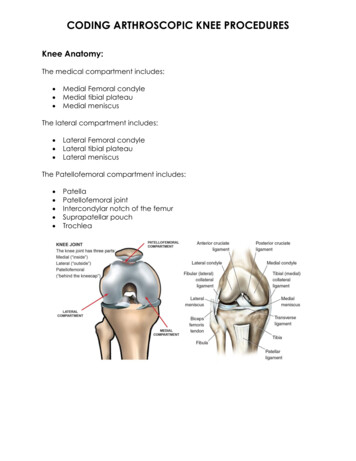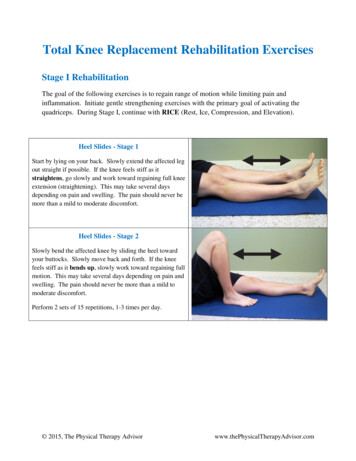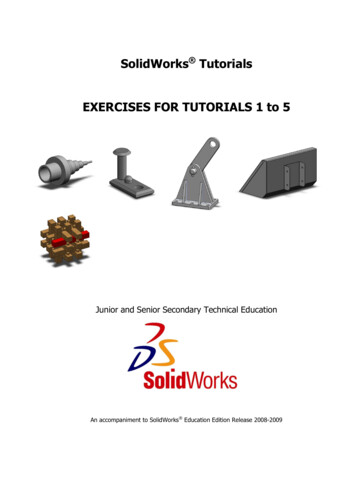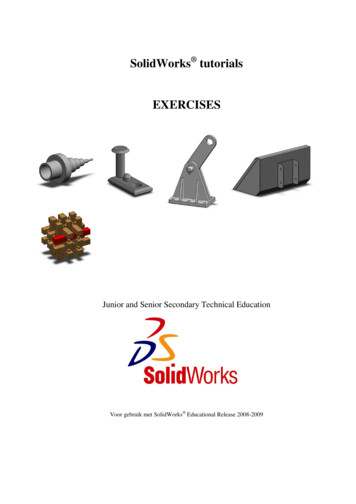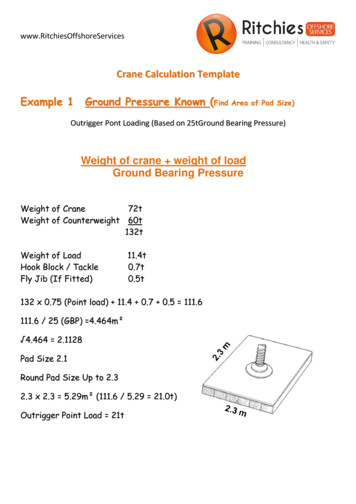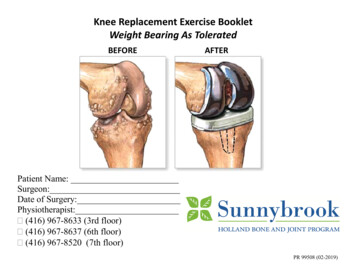
Transcription
Knee Replacement Exercise BookletWeight Bearing As ToleratedBEFOREAFTERPatient Name:Surgeon:Date of Surgery:Physiotherapist: (416) 967-8633 (3rd floor) (416) 967-8637 (6th floor) (416) 967-8520 (7th floor)PR 99508 (02-2019)
Reduce Pain and SwellingIce and Heat: Ice can be applied to your operated leg for 10 –15 minutes. You may find this most helpful after exercise.Ice on the thigh while elevating your leg above your heart helps decrease to swelling. Beginning one week after surgery, you may apply heat behind your knee or on the front of your hip, for 1015 minutes before you exercise. Do not apply heat directly over the incision. Do not use heat if you havebeen prescribed antibiotics for your knee.Pain Medication: Pain medication should be taken as prescribed. It is important that your pain is controlled so that you can complete 2-3 exercise sessions each day andgradually progress your walking. If you have pain when doing your exercises, take your pain medication before starting your exercises. Thegoal is to be 4/10 or lower (low to moderate pain) on the 0-10 pain scale. For more information about pain management visit www.sunnybrook.ca/hipkneepain.Walking Walking is not a substitute for your exercises. Start with short walks throughout the day and slowly increasethem as you improve. A sudden increase in your activity levels may cause more swelling, more stiffnessand more pain.2
My Knee is Getting More Stiff. What do I do?Please assess your knee movement using the diagrams on the following two pages and track yourprogress. On the last page of this booklet a tracking chart is provided for you and your physiotherapistto track your progress. If your knee is feeling more stiff, are you: Doing enough exercise? If your knee is becoming more stiff you should increase to 10 repetitions ofrange of motion exercises every two hours. It is normal to have pain while doing these exercises. Taking the prescribed pain medication as suggested in hospital? Icing your knee frequently? You should ice your knee for 10-15 minutes, especially after theexercises. Allow at least one hour between icing sessions. A bag of frozen peas wrapped in a kitchentowel or pillowcase makes an ideal ice pack. Applying heat to the thigh muscle well above the incision or behind the knee for 10-15 minutesbefore exercises. You should feel a pleasant warmth, not a burning sensation. Elevating your leg above the heart level? You may need to do this for 20 minutes, 2-3 times a day tohelp decrease the swelling (See page 6 for details). Doing too much other activity? Often a sudden increase in activity level is the reason for an increasein knee swelling and stiffness. Decreasing your other activities for a 24-hour period may help. Takemore rest breaks. Staying in one position? For example, if you sit for a prolonged period of time, it can also causestiffness. Be sure to change position frequently.If you have tried the above strategies for 3 days with no improvement please call and leave amessage at : 416.967-85263
At Home Keep Checking That Your Knee Movement is ImprovingEstimate your Knee Bend (flexion):Sitting in a chair with your body weight evenly distributed on both buttocksand your back against the chair, bend your operated knee by sliding your heelunder the seat.If you are unable to bend past position 2 by two weeks (after surgery) call usand leave a message at 416-967-8526.2Your Goal: Footunder the chair1432**If foot cannot move under the chair begin to do one ofexercises #22, #23, #24, #30, #31, #32 more often in the day,suggested 10 repetitions every 2 hours.444
At Home Keep Checking That Your Knee Movement is ImprovingEstimate your Knee Straightening (extension):Push down on your thigh to straighten your knee towards the bed, making sure that your toes arepointing up to the ceiling. Straighten your knee as much as possible towards position B. If you areunable to straighten the knee beyond position A by two weeks after surgery call us and leave amessage at: 416-967-8526.AAB**If you are unable to straighten your kneeflat on the bed, even with hands pushing, beginto do one of exercises #27, #28 or #29 more oftenin the day, suggested 10 repetitions every 2hours.Your goal: Knee straightwith roll under ankle.B5
ElevationElevate your leg regularly to help manage swelling. Toelevate properly, lie down fully with your leg higherthan your heart. Place pillows under your leg so thatyour ankle and knee are higher than your hip. Makesure to keep your knee straight. Stay in this position for20-30 minutes, and repeat several times during the day.Ankle pumping while in this position can also helpreduce swelling.Positioning at Rest: When resting or lying in bedalways keep your knee straight. Do not placepillows directly underneath your knee.Post-operative Exercises It is recommended that these exercises be taught to you by a physiotherapist.Not every exercise is needed, your physiotherapist will determine which are important for you.In the first few weeks at home it is important that you continue to improve your knee bendingand straightening.Repeat Each Exercise 3 Times Per Day6
Post-operative Exercises1. Static Quadriceps StrengtheningThis exercise may also be done while sitting up.Tighten the muscle on the front of youroperated thigh to press your knee into the bedand bring toes towards you. Hold 5 seconds.Repeat 10 times.2. Knee Bend With Leg Press Place a sheet around the foot of your operatedleg. Use it to help bend the operated knee.Keep your heel on the bed.Hold 5 seconds. Tighten the muscles in the front of your legand push your foot against the resistance ofthe sheet until your knee is straight.Keep your heel on the bed.Repeat 10 times.7
Post-operative Exercises3a. Roll Stretch Place the heel of your operated leg on a roll with the toespointed to the ceiling.Tighten your front thigh muscles to press your operatedknee down toward the bed.Place your hands above the knee (as shown) and press downto help maximize the stretch behind your knee. Do notbounce with your hand, hold the stretch instead.Hold 10-20 seconds.Repeat 5-10 times.3b. Knee Extension in SittingSit on the edge of a chair with your operated knee straight andunoperated knee bent. Point your toes towards the ceiling and push downwards on yourleg, above the knee, to straighten it (as shown). Make sure that you are sitting up straight with your back arched. To increase the stretch, slowly lean forward while maintaining anarched back and keeping your chest up and forward. Hold: 10-20 seconds.Repeat: 5-10 times.8
Post-operative Exercises4. Active-Assisted Quads Over Roll Place a roll under your operated knee and a sheetaround your foot.Push your knee down into the roll, contract themuscles in the front of your leg and lift your foot ashigh as you can, using the sheet to assist.Once your knee is straight try to let go of the sheetand hold that position using the muscle (keeppressing the back of your knee down).(*note: the sheet only assists to raise/lower the foot)5. Sitting Knee Extension Sit on a firm surface, chest up with low back arched.Tighten the muscles on the front of your thigh(Quadriceps) to straighten your operated knee.Keep your thigh pressing down on the chair as yourraise your foot. Feel the stretch behind your thighand knee.Lower your leg slowly.Hold 5-15 seconds.Repeat 5 times.Hold 5-10 seconds.Repeat 10 times.9
Post-operative Exercises6. Knee Bend Progressiona)Sitting on the bed or chair,bend your operated knee bysliding your heel under the seat.You may use a plastic bag to assistwith sliding the heel back.Hold 10-20 seconds.Repeat 10 times.b) Cross your non-operated ankleover your operated ankle, anduse it to help bend your operatedknee. Ensure you do not lift yourbuttock off the bed.Hold 10-20 seconds.Repeat 10 times.c) Bend your operated knee withassistance of a belt (as shown). Loopthe belt around the ankle of youroperated leg. Bring it up and over yourshoulder and pull.Hold 10-20 seconds.Repeat 10 times.Keep yourbuttocks onthe chair10These are 3 different exercises that you can use to improve your knee bend
How To Manage Stairs One At A TimeTo go up the stairs:1. Put your non-operated leg on the step.2. Use the cane and handrail to help step up.3. Bring your operated leg up to the same step.To go down the stairs:1. Lead with the cane and the operated leg first.2. Bring non-operated leg down to the same step.As your knee range of motion and strength improves, you will eventually be able toresume “normal” stair pattern (i.e. up and down with either leg, reciprocal)11
Exercise InstructionsStrengthening exercises: Start by doing your strengthening exercises daily. Start with 1 set of 8-15 repetitions. Progress gradually to 3 sets of 8-15 repetitions, take a 1-2 minute break between sets. Once you are able to do 3 sets of 8-15 repetitions, you can begin doing them every other day (3-4 times a week). You do not need to hold the exercise position, instead move slowly and smoothly with control. Move on to an exercise labeled “progression” when you can easily complete 3 sets of 8-15repetitions. Not every exercise is needed and not every exercise will be right for you. Your physiotherapistwill determine which are important for you.Remember: Knee joint pain is normal and expected with exercise after having knee replacementsurgery. Doing your exercises regularly is very important in order to restore range of motion andfunction. Be sure to take your pain medications 45 minutes before you exercise to best controlyour pain.12
Strengthening Exercises7. Chair Rise Stand in front of a chair with your feet and knees hip-width apart.With your weight distributed evenly between yourfeet, stick your buttocks back and slowly sit downwithout using your hands.Pause breifly and then stand up fully, again withoutusing your hands.If needed, you may use your hands to assist you inraising and lowering from the chair. Progress to notusing your hands.Progression: Tie a Theraband around your thighs (above yourknees) and hold a theraband as pictured, withyour thumbs up.Start with your knees, feet and hands hip-widthapart.Lower and raise off of the chair whilemaintaining outward pressure on each band (hip-width apart).Knees remain in line with feet and not ahead oftoes.13
Strengthening Exercises8. Quarter Squat9. Standing Hip Abduction Stand in front of a chair/sinkand keep equal weight throughboth feet.Keep your toes pointingforwards.Bend your knees and stick yourbuttocks out.Lower your bum down slowlyand with control, using handsupport if needed.Ensure to complete as a slowcontrolled movement withoutholding the squat position. Hold onto a counter for balance.Stand tall and move your operated leg out tothe side.Make sure to keep your hips level and upperbody straight. Do not hike your hip.Keep your toes pointing forwardProgression: tie a theraband around both legs,above your knees.Progression: Stand on operatedleg only and perform quartersquat. Hold on to a support asneeded.Do not allow your knees to goahead of your toes14
Strengthening Exercises10. Heel Raises Holding on to support if needed, raise yourheels off the floor.Do not let your knees bend as you lift.Progression: Stand only on your operated legand complete the same heel raise.11. Marching in Standing Hold onto a counter for support if needed.Bend your knee and lift your bent kneetowards your chest.Bend your knee further back as you raise theleg up.Keep your back straight and alternate sides.Progression: March on the spot without handsupport.15
Strengthening and Balance Exercises12. Seated Hamstring Curls Sitting in a chair, place a theraband aroundthe ankle of your operated leg.Bend your knee against the resistance ofthe band, keeping your foot off of the floor.Keep equal weight through both buttocks.Slowly allow your leg to return to thestarting position.13. Single Leg BalanceBalance on your operated leg, holding on to acounter for support if needed. Squeeze your buttocks together and make sureto keep your hips level. Try to practice in front of a mirror to avoidhiking your hips. Try to hold for 30 seconds. Repeat 3 times.Progression: once you can stand without holdingon, progress to standing on an uneven surface suchas a pillow, a wobble board or a Bosu ball. 16
Strengthening Exercises14. Lateral Step Up Stand facing sideways with your operated foot on thestep.Step up by straightening the operated knee, but donot let you knee move over your toes.Slowly lower your non-operated leg to the floor bybending your hips and knees and sticking your bottomback. Make sure you can see your toes.Picture A If a full step is too challenging, start with yourunoperated foot on a stool or book.Picture B For a different challenge, loop a length of therabandaround your operated knee and the rung of yourstairwell (or another stable object). Keep the same starting position as before. As you stepup, straighten your knee against the resistance of theband. When you begin to lower your non-operated leg to thefloor, do so as slowly as possible. Do not let the kneebend quickly.AB**Helpful Tip: Increase the step height as able. Begin with a 2-4 inch step, progress to a 6 inch then 8 inchstep height. (A book beside the step allows for step height progression if needed)17
Strengthening Exercises15. Clam ShellLie on your non-operated side with your hipsand knees slightly bent and your hips stackedon top of each other. Keep your feet together and open your kneesas much as you can without letting your tophip roll backwards.Note: if possible, push your feet against a wall orheadboard as you lift your top knee. Progression: Tie a theraband around your lowerthighs, just above your knees. You may want tostart off with a light resistance band.16. Bridge Start by lying on your back with yourknees bent to 90 degrees.Squeeze your buttocks and lift yourbottom off the bed.Progression Lift buttocks off the bed with both feeton bed. Once you are up, lift your non-operatedleg up an inch. Keep your unoperated leg up as youlower buttocks back to the bed.18
Strengthening Exercises17. Crab Walk Bring your feet together and tie a band just above your knees.Stand with your feet hip-width apart.Stick your buttocks out as if you are about to sit in a chair.Do not allow your knees to go ahead of your toes.Press your thighs apart against the tension of the band.Maintain this squat position and take a few steps in one direction, then side stepback in the other direction.When stepping feet back together, don’t bring your feet closer than hip-width apart.Repeat in opposite direction until you are back to your starting position.12319
Strengthening Exercises18. Standing Abduction Against WallStand on your operated leg, bend your nonoperated knee and push against a wall. Your hip should not be touching the counter. Slowly push your knee outwards against thewall. Make sure to keep your hips level and thighs inline.Progression: try to take your hand off the counterso that your lower leg is the only part of yourbody touching the wall. 19. Hamstring CurlWhile supporting yourself with your hands, bringthe heel of the operated leg towards yourbuttock. Remain standing up tall. Move your thigh backward to keep it beside theother leg.Progression: Use an ankle weight around your ankleto increase the difficulty. 20
Strengthening Exercises20. Terminal Knee Extension SquatStand with your feet hip-width apart and loop atheraband around your operated knee and leg ofheavy chair or table.Bend both knees and stick your buttocks back to perform a small squat.Straighten your knees and hips and return to thestarting positionAs you straighten your knees, pull back on the bandwith your operated knee. 21. Isolated Terminal Knee Extension In standing with your feet hip-width apart, tie aband around your operated knee and around theleg of a heavy chair or table.Bend your operated knee slightly, and thenstraighten it by pulling back against the band.Make sure not to rotate your hips backwards.21
Exercise InstructionsStretches: Warm up for 5-10 minutes prior to stretching (eg. walking, warm shower, stationary bike). Hold for 45 seconds (or 5 slow deep breaths) and repeat 3 times (unless stated otherwise). Stretch often every day, at least 2-3 times per day. Not every exercise is needed and not every exercise will be right for you. Your physiotherapistwill determine which are important for you.Stretches22. Quadriceps Stretch Lying on Back Start by lying at the edge of the bed.One hand hugs your non-operated leg up towardschest while you bend your operated knee with thehelp of a sheet or belt in the other hand.You should feel a stretch in the front of your thigh.OperatedKnee22
Stretches23. Quadriceps Stretch Lying on Stomach Wrap a belt around the ankle of your operatedleg.Pull the belt to bring the heel of your operatedleg toward your buttocks.Once you feel a strong stretch in the front ofyour thigh hold it for 45 seconds and then let goof the belt and try to hold it using your muscles.24. Quadriceps Stretch In Standing Hold the foot of your operated legusing a towel.Pull on the towel upwards and bringyour heel towards your buttocks until astretch is felt in the front of your thigh.Keep your knees parallel and keepoperated knee pointed to the floor. Donot bend at hip.23
Stretches25. Hamstring Stretch (Long Sitting) Sit on the edge of a chair with your knee straightand your toes pointed towards the ceilingKeep you chest up while you move your chestforward until a stretch is felt behind the thigh andknee (hands push on bed to help lift chest up).Knee straight26. Calf Stretch Holding on to a support, place your operatedleg behind you.Keep your operated knee straight and the heelon the ground.Bend your non-operated knee until you feel astretch in the calf muscle of the operated leg.Be sure to keep your chest up tall.24
Extension Progression Stretches27. Coach Assisted Knee Extension On A RollThis is similar to exercise #3.The coach can assist to regain straightening of the operated knee.The coach pushes down with two hands above the knee. **Youshould guide your coach to hold a stretch that is tolerable for you.Hold 10-20 seconds.Repeat 5-10 times.28. Weighted Knee Extension In SittingSitting as shown, tie the handles of two bags together with equal weight in eachbag and place it around your operated leg above the kneecap (one bag hangs oneach side). Ensure the weight is NOT directly on your knee. Allow your knee torelax and “sink” towards the floor. You should feel a stretch behind your knee.Hold 5-10 minutes.Repeat 2-3 times/day.29. Gravity Assisted Knee Extension StretchLie on your stomach with your operated knee, foot and ankleoff the end of bed. Place a towel under your thigh just abovethe knee. To add stretch, place two bags around your leg asshown and place light weights in each bag.Hold 5-10 minutes.Repeat 2-3 times/day.Use heat on back of knee during stretch25
Flexion Progression Stretches30. Coach Assisted Knee Bend / Hamstring StrengthThis is similar to exercise #6. In this exercise the coach is helping to increase knee bend.**You should guide your coach to hold a stretch that is tolerable for you.Keep your buttocks on the bed, do not lean away.a) Push the operated leg backagainst the coach’s hand and holdin position for 5 seconds.b) Relax the operated leg, allow the coach to press down on thetop of the knee cap and pull the ankle down while you pull on thebelt to bend your knee further. Hold 10-15 seconds.Repeat above sequence of a) and b) 10 times.26
Flexion Progression Stretches31. Prolonged Knee Flexion Against a Wall Start by sitting upright in a chair with your toesagainst wall.Shift your buttocks forward in the chair and tryto bring your knee towards the wall.Keep shifting forward until you can touch thewall and feel a strong stretch in your knee.Hold the position up to 20 minutes with heaton your thigh.To progress your knee bend further, place a bookagainst the wall and position your toes behind thebook. Repeat the exercise as written above.32. Forward Knee Lunge Stretch Place the foot of your operated leg on a step.Lunge forward to bend your operated knee.Use support as needed and keep your body up tall.Hold 10-20 seconds.Repeat 5-10 times.27
Cycling33. Stationary CyclingTo gain range of motion:Without any resistance on the stationary bicycle, start byrocking back and forth trying to bend the knee further eachtime. Once you can achieve a full revolution you can lowerthe seat to increase your range of motion further.To improve strength:Adjust the height of the seat so that your knee is slightly bentwhen the pedal is at its lowest point.As your knee gets stronger you may gradually increase theresistance up to a moderate level and increase the speed ofcycling to make the exercise more challenging (i.e. pedalspeed at 90 revolutions per minute (RPM)). Ensure that youare not working too hard by being able to carry on aconversation while cycling.Increase resistance for up to one minute then decrease theresistance for 2 minutes (similar to going up and down hills),try to maintain your pedal speed at least at 60 RPM’s evenwith additional resistance.*Cycling can help you to improverange of motion, strength andoverall fitness level.Gradually increase cycling to 15-20minutes.28
Exercises In The GymThe following exercises can be done if you have access to gym equipment.If you are not familiar with the equipment, consult a fitness instructor or a physiotherapist.34. Leg PressBegin the exercise with your knee bent at 90degrees. Push against the weight to straightenthe knee in a slow controlled movement andthen release back slowly.The leg press is not for everyone– consultyour physiotherapist before attempting.35. Hamstring CurlsLie on your stomach with the leg straight and thebar on top of the ankle. Using a slow controlledmovement, bend the knee to bring the foottowards the buttock and release back slowly.For the above exercises, start with 1 set of 8-15 repetitions and progress to 3 sets.your muscles should feel tired after the exercise, if not increase the weight next time.29
Resuming an Active LifestyleWhen you can return to your leisure activities after surgery depends on the physical demands of the activity and yourstage of recovery.** Do not take up new sporting activities as inexperienced people are at ahigher risk for injuries and accidents**Walking: This is an excellent activity, and you are strongly encouraged to gradually increase your walking distanceafter you leave the hospital. Walk outdoors as long as the sidewalks are dry or consider going to a nearby mall to walkindoors when the sidewalks are wet and slippery.Stationary Cycling: can be resumed 1-2 weeks following your surgery. Refer to page 27 for details.Swimming / Aqua-fit: can be resumed 6-12 weeks following surgery only if the incision is well healed and dry. Nowhip kick but gentle breast stroke and flutter kick is allowed. Avoid side-to-side leg exercise in Aqua-fit (i.e. jumpingjacks).Activities that may be resumed after Surgeon/APP Follow-up (approx. 6-8 weeks) Driving may be started sooner if you are not taking opiod pain medication and are able to climb stairs reciprocally(normal pattern), only on the advice of your surgeon Golf - begin at the driving range GardeningKneeling: It is NOT harmful to kneel on your new knee, however kneeling may bepainful. The use of a padded surface or pillow is recommended when kneeling. Forexample, a kneeling platform is recommended for gardening.Kneeling Platform30
Activities that may be resumed at 12 weeks Bowling (Lawn or Indoors) Golf - you may return to the course (may be started earlier than 12 weeks as long as ableto walk without aids, and completed balance/core exercises) Outdoor cycling (NOT Mountain Biking) Low impact aerobic exercise Doubles tennisHigh risk activitiesAll of the following activities are associated with slippery or unstable surfaces and increase your risk of falling.In addition, these activities can result in significantly higher forces on the replaced joint than are consideredsafe. It is not recommended to begin to learn one of these activities after your surgery. In the case of a highlyexperienced or expert athlete, the activity may be discussed further with the surgeon. Downhill skiingCross-country skiingIce skatingInline skating Mountain bikingCanoeingSailingKayakingHigh risk activities that are NEVER permitted Singles tennisJogging / RunningSquash / RacquetballBasketballHigh impact aerobics Weight Training: Heavy lifting is neverrecommended.Generally it is recommended to uselighter to moderate resistance andincrease the challenge by increasing thenumber of repetitions performed.31
General Aerobic Fitness SuggestionsBe active! You can return to activities you used to do before surgery using the following guidelines. However,if you have not been active before your surgery, please consult your family physician before starting toexercise.It is important to start slowly and gradually progress (i.e. increase the amount of time you exercise or thedistance you are covering) to being more active.Canadian Physical Activity Guidelines recommend: 150 minutes of moderate to intense aerobic physical activity (sweating a little bit and breathingharder) per week, in sessions of 10 minutes or more. Muscle and bone strengthening at least 2 times per week. More physical activity provides greater health benefits.For more information about exercising after your knee replacement, please visit our ationCopyright 2005-2018;Sunnybrook Health Sciences CentreAll rights reserved by Sunnybrook Health Sciences Centre, operating as the Holland Orthopaedic & Arthritic Centre. No part of this publication may be reproduced or transmitted by any means,including photocopying and recording, or stored in a retrieval system of any nature without the written permission of Sunnybrook Health Sciences Centre: 43 Wellesley Street East, Toronto, OntarioM4Y 1H1 (416) 967-862632
Tracking you Knee Range of MotionDateKnee StraighteningKnee Bending33
3. ring your operated leg up to the same step. To go down the stairs: 1. Lead with the cane and the operated leg first. 2. ring non-operated leg down to the same step. As your knee range of motion and strength improves, you will eventually be able to resume “normal” stair pattern (i.e.
